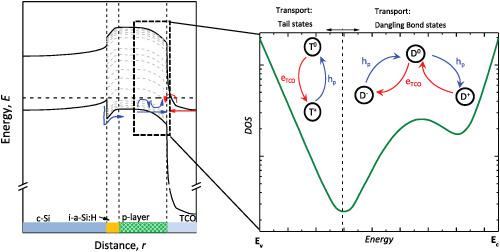当前位置:
X-MOL 学术
›
Prog. Photovoltaics
›
论文详情
Our official English website, www.x-mol.net, welcomes your
feedback! (Note: you will need to create a separate account there.)
The role of heterointerfaces and subgap energy states on transport mechanisms in silicon heterojunction solar cells
Progress in Photovoltaics ( IF 8.0 ) Pub Date : 2020-06-05 , DOI: 10.1002/pip.3300 Paul Procel 1 , Haiyuan Xu 1 , Aurora Saez 1 , Carlos Ruiz‐Tobon 1 , Luana Mazzarella 1 , Yifeng Zhao 1 , Can Han 1 , Guangtao Yang 1 , Miro Zeman 1 , Olindo Isabella 1
Progress in Photovoltaics ( IF 8.0 ) Pub Date : 2020-06-05 , DOI: 10.1002/pip.3300 Paul Procel 1 , Haiyuan Xu 1 , Aurora Saez 1 , Carlos Ruiz‐Tobon 1 , Luana Mazzarella 1 , Yifeng Zhao 1 , Can Han 1 , Guangtao Yang 1 , Miro Zeman 1 , Olindo Isabella 1
Affiliation

|
The contact resistivity is a key parameter to reach high conversion efficiency in solar cells, especially in architectures based on the so‐called carrier‐selective contacts. The importance of contact resistivity relies on the evaluation of the quality of charge collection from the absorber bulk through adjacent electrodes. The electrode usually consists of a stack of layers entailing complex charge transport processes. This is especially the case of silicon heterojunction (SHJ) contacts. Although it is known that in thin‐film silicon, the transport is based on subgap energy states, the mechanisms of charge collection in SHJ systems is not fully understood yet. Here, we analyse the physical mechanisms driving the exchange of charge among SHJ layers with the support of rigorous numerical simulations that reasonably replicate experimental results. We observe a connection between recombination and collection of carriers. Simulation results reveal that charge transport depends on the alignment and the nature of energy states at heterointerfaces. Our results demonstrate that transport based on direct energy transitions is more efficient than transport based on subgap energy states. Particularly, for positive charge collection, energy states associated to dangling bonds support the charge exchange more efficiently than tail states. The conditions for optimal carrier collection rely on the Fermi energy of the layers, in terms of activation energy of doped layers and carrier concentration of transparent conductive oxide. We observe that fill factor (FF) above 86% concurrently with 750‐mV open circuit voltage can be attained in SHJ solar cells with ρc lower than 45 mΩ·cm2 for p‐contact and 20 mΩ·cm2 for the n‐contact. Furthermore, for achieving optimal contact resistivity, we provide engineering guidelines that are valid for a wide range of silicon materials from amorphous to nanocrystalline layers.
中文翻译:

异质界面和亚能隙能态在硅异质结太阳能电池传输机制中的作用
接触电阻率是在太阳能电池中达到高转换效率的关键参数,尤其是在基于所谓的载流子选择性接触的架构中。接触电阻率的重要性取决于对从吸收体到相邻电极的电荷收集质量的评估。电极通常由需要复杂的电荷传输过程的层堆叠组成。硅异质结(SHJ)触点尤其如此。尽管众所周知,在薄膜硅中,传输是基于亚带隙能态的,但SHJ系统中电荷收集的机制尚不完全清楚。在这里,我们在严格复制数值模拟的支持下,分析了驱动SHJ层之间电荷交换的物理机制。我们观察到重组和载体收集之间的联系。仿真结果表明,电荷传输取决于异质界面处的排列和能态的性质。我们的结果表明,基于直接能量转换的运输要比基于次能级能量状态的运输更有效。特别地,对于正电荷收集,与悬空键相关的能态比尾态更有效地支持电荷交换。就掺杂层的活化能和透明导电氧化物的载流子浓度而言,最佳载流子收集的条件取决于层的费米能。我们观察到填充因子(仿真结果表明,电荷传输取决于异质界面处的排列和能态的性质。我们的结果表明,基于直接能量转换的运输要比基于次能级能量状态的运输更有效。特别地,对于正电荷收集,与悬空键相关的能态比尾态更有效地支持电荷交换。就掺杂层的活化能和透明导电氧化物的载流子浓度而言,最佳载流子收集的条件取决于层的费米能。我们观察到填充因子(仿真结果表明,电荷传输取决于异质界面处的排列和能态的性质。我们的结果表明,基于直接能量转换的运输要比基于次能级能量状态的运输更有效。特别地,对于正电荷收集,与悬空键相关的能态比尾态更有效地支持电荷交换。就掺杂层的活化能和透明导电氧化物的载流子浓度而言,最佳载流子收集的条件取决于层的费米能。我们观察到填充因子(对于正电荷收集,与悬空键关联的能态比尾态更有效地支持电荷交换。就掺杂层的活化能和透明导电氧化物的载流子浓度而言,最佳载流子收集的条件取决于层的费米能。我们观察到填充因子(对于正电荷收集,与悬空键关联的能态比尾态更有效地支持电荷交换。就掺杂层的活化能和透明导电氧化物的载流子浓度而言,最佳载流子收集的条件取决于层的费米能。我们观察到填充因子(FF)750 mV的开路电压同时86%以上可以达到在SHJ太阳能电池ρ Ç比45毫欧·降低厘米2为p接触和20MΩ·厘米2的n接触。此外,为了获得最佳的接触电阻率,我们提供了适用于从非晶层到纳米晶层的各种硅材料的工程指导。
更新日期:2020-06-05
中文翻译:

异质界面和亚能隙能态在硅异质结太阳能电池传输机制中的作用
接触电阻率是在太阳能电池中达到高转换效率的关键参数,尤其是在基于所谓的载流子选择性接触的架构中。接触电阻率的重要性取决于对从吸收体到相邻电极的电荷收集质量的评估。电极通常由需要复杂的电荷传输过程的层堆叠组成。硅异质结(SHJ)触点尤其如此。尽管众所周知,在薄膜硅中,传输是基于亚带隙能态的,但SHJ系统中电荷收集的机制尚不完全清楚。在这里,我们在严格复制数值模拟的支持下,分析了驱动SHJ层之间电荷交换的物理机制。我们观察到重组和载体收集之间的联系。仿真结果表明,电荷传输取决于异质界面处的排列和能态的性质。我们的结果表明,基于直接能量转换的运输要比基于次能级能量状态的运输更有效。特别地,对于正电荷收集,与悬空键相关的能态比尾态更有效地支持电荷交换。就掺杂层的活化能和透明导电氧化物的载流子浓度而言,最佳载流子收集的条件取决于层的费米能。我们观察到填充因子(仿真结果表明,电荷传输取决于异质界面处的排列和能态的性质。我们的结果表明,基于直接能量转换的运输要比基于次能级能量状态的运输更有效。特别地,对于正电荷收集,与悬空键相关的能态比尾态更有效地支持电荷交换。就掺杂层的活化能和透明导电氧化物的载流子浓度而言,最佳载流子收集的条件取决于层的费米能。我们观察到填充因子(仿真结果表明,电荷传输取决于异质界面处的排列和能态的性质。我们的结果表明,基于直接能量转换的运输要比基于次能级能量状态的运输更有效。特别地,对于正电荷收集,与悬空键相关的能态比尾态更有效地支持电荷交换。就掺杂层的活化能和透明导电氧化物的载流子浓度而言,最佳载流子收集的条件取决于层的费米能。我们观察到填充因子(对于正电荷收集,与悬空键关联的能态比尾态更有效地支持电荷交换。就掺杂层的活化能和透明导电氧化物的载流子浓度而言,最佳载流子收集的条件取决于层的费米能。我们观察到填充因子(对于正电荷收集,与悬空键关联的能态比尾态更有效地支持电荷交换。就掺杂层的活化能和透明导电氧化物的载流子浓度而言,最佳载流子收集的条件取决于层的费米能。我们观察到填充因子(FF)750 mV的开路电压同时86%以上可以达到在SHJ太阳能电池ρ Ç比45毫欧·降低厘米2为p接触和20MΩ·厘米2的n接触。此外,为了获得最佳的接触电阻率,我们提供了适用于从非晶层到纳米晶层的各种硅材料的工程指导。










































 京公网安备 11010802027423号
京公网安备 11010802027423号